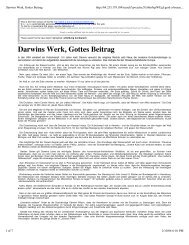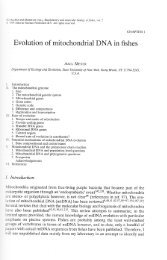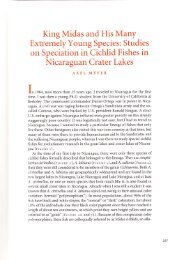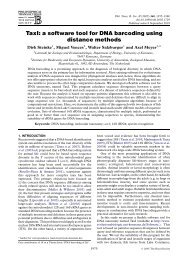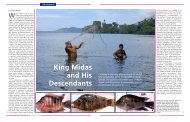Cichlids of the Rift Lakes - Scientific American Digital
Cichlids of the Rift Lakes - Scientific American Digital
Cichlids of the Rift Lakes - Scientific American Digital
You also want an ePaper? Increase the reach of your titles
YUMPU automatically turns print PDFs into web optimized ePapers that Google loves.
scribed earlier) have probably arisen because <strong>of</strong><br />
<strong>the</strong> preferences <strong>of</strong> <strong>the</strong> females. In this case, sexual<br />
selection, ra<strong>the</strong>r than pressure for physical survival,<br />
seems to have driven <strong>the</strong> diversification. The<br />
different colors <strong>of</strong> o<strong>the</strong>rwise identical fish can<br />
serve as a barrier separating distinct species, because<br />
a female Tropheus, for instance, that prefers<br />
yellow males will not mate with a red one.<br />
Secrets in <strong>the</strong> Genes<br />
Until very recently, biologists did not know how<br />
<strong>the</strong>se hundreds <strong>of</strong> cichlid species were related.<br />
Modern molecular techniques have now answered<br />
some <strong>of</strong> <strong>the</strong>se questions and raised many o<strong>the</strong>rs.<br />
Although <strong>the</strong> genetic research confirms several early<br />
hypo<strong>the</strong>ses based on anatomy, it sometimes<br />
conflicts spectacularly with entrenched ideas.<br />
As initially suggested by Mutsumi Nishida <strong>of</strong><br />
Fukui Prefectural University, early lineages <strong>of</strong> cich-<br />
LAKE TANGANYIKA SPECIES LAKE MALAWI SPECIES<br />
Julidochromis ornatus<br />
Tropheus brichardi<br />
Bathybates ferox<br />
Cyphotilapia frontosa<br />
Lobochilotes labiatus<br />
DISTANTLY RELATED CICHLIDS from <strong>Lakes</strong> Tanganyika and Malawi have evolved<br />
to become uncannily alike by virtue <strong>of</strong> occupying similar ecological niches. They demonstrate<br />
how morphological resemblance may have little correlation with genetic closeness<br />
or evolutionary lineage (phylogenetic relationship). All <strong>the</strong> cichlids <strong>of</strong> Lake Malawi are<br />
more closely related to one ano<strong>the</strong>r than to any cichlids in Lake Tanganyika.<br />
68 <strong>Scientific</strong> <strong>American</strong> February 1999<br />
Melanochromis auratus<br />
Pseudotropheus microstoma<br />
Ramphochromis longiceps<br />
lids from West Africa first colonized Lake Tanganyika.<br />
The cichlids <strong>of</strong> this ancient lake are genetically<br />
diverse, corresponding to 11 lineages<br />
(that is, deriving from 11 ancestral species). Much<br />
later some <strong>of</strong> <strong>the</strong>se fishes left <strong>the</strong> lake’s confines<br />
and invaded East African river systems, through<br />
which <strong>the</strong>y reached <strong>Lakes</strong> Victoria and Malawi.<br />
Studies <strong>of</strong> <strong>the</strong> genetic material called mitochondrial<br />
DNA conducted by one <strong>of</strong> us (Meyer) and our<br />
colleagues show that <strong>the</strong> cichlids in Lake Victoria<br />
are genetically very close to one ano<strong>the</strong>r—far closer<br />
than to morphologically similar cichlids in <strong>the</strong><br />
o<strong>the</strong>r two lakes. They derive almost entirely from<br />
a single lineage <strong>of</strong> mouth brooders.<br />
This scenario implies that almost identical evolutionary<br />
adaptations can and did evolve many times<br />
independently <strong>of</strong> one ano<strong>the</strong>r. <strong>Cichlids</strong> with singular<br />
anatomical features—designed to feed on o<strong>the</strong>r<br />
fish or on eggs and larvae, to nip <strong>of</strong>f fins, scrape algae,<br />
tear <strong>of</strong>f scales, crush mollusks or any <strong>of</strong> myriad<br />
o<strong>the</strong>r functions—occur in all three<br />
lakes. To some <strong>of</strong> us biologists, such features<br />
had seemed so unique and so unlikely<br />
to evolve more than once that we<br />
had held that fishes with <strong>the</strong> same specializations<br />
should be closely related.<br />
If that were so, <strong>the</strong> predilection to<br />
scrape algae (for instance) would have<br />
Cyrtocara moorei<br />
Placidochromis milomo<br />
Copyright 1999 <strong>Scientific</strong> <strong>American</strong>, Inc.<br />
ROBERTO OSTI<br />
evolved only once, its practitioners having<br />
later dispersed. But algae scrapers in<br />
Lake Victoria and Lake Malawi have<br />
evolved independently <strong>of</strong> those in Lake<br />
Tanganyika, from an ancestor with<br />
more generalized capabilities. The genetic<br />
studies thus show that evolution repeatedly<br />
discovers <strong>the</strong> same solutions to<br />
<strong>the</strong> same ecological challenges.<br />
It also appears that morphological<br />
characteristics can evolve at an incredibly<br />
uneven pace, sometimes completely<br />
out <strong>of</strong> step with genetic changes. Some<br />
<strong>of</strong> Lake Tanganyika’s species have<br />
physically altered very little over time—<br />
a number <strong>of</strong> fossil cichlids, especially<br />
tilapias, look very similar to <strong>the</strong>ir modern<br />
descendants in <strong>the</strong> lake. And apart<br />
from <strong>the</strong>ir color, <strong>the</strong> Tropheus species<br />
remained (morphologically) almost unchanged.<br />
On <strong>the</strong> o<strong>the</strong>r hand, <strong>the</strong> cichlids<br />
<strong>of</strong> Lake Victoria—with <strong>the</strong>ir diversity<br />
in size, pattern and shape—evolved<br />
in an extremely short time span. Amazingly,<br />
<strong>the</strong> lake’s more than 400 species<br />
contain less genetic variation than <strong>the</strong><br />
single species Homo sapiens. Molecular<br />
clocks that are roughly calibrated on<br />
<strong>the</strong> rate <strong>of</strong> mutations in mitochondrial<br />
DNA suggest that <strong>the</strong> entire assemblage<br />
<strong>of</strong> Lake Victoria cichlids arose within<br />
<strong>the</strong> past 200,000 years.<br />
Recent paleoclimatological data from<br />
Thomas C. Johnson <strong>of</strong> <strong>the</strong> University <strong>of</strong><br />
Minnesota and his colleagues point to<br />
<strong>Cichlids</strong> <strong>of</strong> <strong>the</strong> <strong>Rift</strong> <strong>Lakes</strong>



